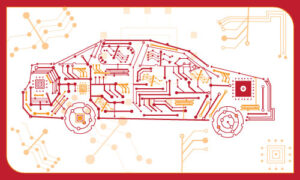Cars are becoming more technologically advanced at an incredibly rapid pace. Like any connected system, a vehicle with an externally connected computer system comes with security vulnerabilities. Features like Bluetooth, touchscreens, and automated updates that enhance convenience also introduce potential security risks. This guide will help you understand the potential threats of this technology and how to protect yourself and your vehicle from hackers.
The Rise of Connected Cars and Cybersecurity Concerns
As vehicles become more connected and share data with other vehicles, infrastructure, and the internet, they may become potential targets for cyberattacks.
While the concept of a hacked car might seem like something out of a sci-fi movie, the reality is that the risks are real and growing.
The National Highway Traffic Safety Administration (NHTSA) is at the forefront of addressing this concern. They are actively researching and developing strategies to protect drivers and passengers.
How Vehicle Cybersecurity Works
The NHTSA says that a multi-layered approach is key to safeguarding vehicles from cyberattacks.
This involves protecting entry points, both wireless and wired, and implementing systems to detect and respond to potential threats.
NHTSA is exploring various methods, including:
- Prioritizing the security of critical vehicle control systems.
- Developing systems to quickly identify and address cybersecurity incidents.
- Designing vehicles to withstand attacks and recover quickly.
- Fostering information sharing among automakers to learn from incidents and improve overall security.
The Reality of Car Hacking
While remote hacks are feasible, most recent car hacking incidents have involved physical access to the vehicle, often through the onboard diagnostic (OBD-II) port.
Automakers are investing in cybersecurity measures, including over-the-air software updates to patch vulnerabilities.
Protecting Yourself and Your Vehicle
Although cybersecurity measures are being added to modern vehicles, there are also precautions that drivers can take:
- Keep your vehicle’s software updated with the latest security patches.
- Avoid unnecessary wireless connections to reduce potential attack surfaces.
- Store your key fob in a metal container to prevent signal interception.
- Avoid leaving devices, such as diagnostic scanners, plugged into the OBD-II port for longer than needed.
By taking a few extra safety precautions, you can enjoy the benefits of connected car technology while protecting yourself against hackers.
Learn more here:
- https://www.nhtsa.gov/research/vehicle-cybersecurity#cybersecurity-protection-methods
- https://www.nhtsa.gov/crash-avoidance/automotive-cybersecurity
- https://www.unr.edu/nevada-today/news/2023/atp-electric-cars-and-hacking
- https://www.capitalone.com/cars/learn/finding-the-right-car/how-cars-are-hacked/2271




